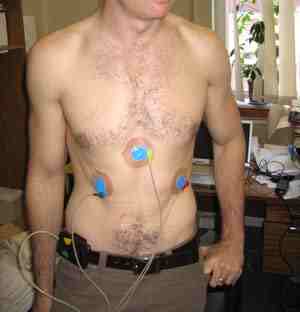Holter Monitor - 24 hour ECG

A Holter monitor is fitted underneath the patient's clothing
A Holter monitor, also called an ambulatory or 24 hour ECG, named after its inventor, Dr. Norman J. Holter, is a portable device for continuously monitoring the electrical activity of the heart. It is usually fitted to a patient by a technician for 24 hours.The patientthen goes about their normal daily activity whilst the device continuously records the ECG. Its extended recording period is sometimes useful for observing occasional cardiac arrhythmias that would be difficult to identify in a shorter period of time.
Much like standard electrocardiography (ECG), the Holter monitor records electrical signals from the heart via a series of electrodes attached to the chest. The number and position of electrodes varies by model, but most Holter monitors employ from three to eight. These electrodes are connected to a small piece of equipment that is attached to the patient's belt, and is responsible for recording the heart's electrical activity throughout the recording period.
Modern units record onto digital flash memory devices. The data are uploaded into a computer which then automatically analyzes the input, counting ECG complexes, calculating summary statistics such as average heart rate, minimum and maximum heart rate, and finding candidate areas in the recording worthy of further study by the technician. The analysis and report are supervised and reported by a cardiologist who can use the information in conjunction with the patient’s history and other diagnostic tests to determine the best management strategy.

Modern devices are compact and lightweight to allow patients to go about their normal daily activity